Multimodal Sentiment Analysis
Papers and Code
QiNN-QJ: A Quantum-inspired Neural Network with Quantum Jump for Multimodal Sentiment Analysis
Oct 31, 2025Quantum theory provides non-classical principles, such as superposition and entanglement, that inspires promising paradigms in machine learning. However, most existing quantum-inspired fusion models rely solely on unitary or unitary-like transformations to generate quantum entanglement. While theoretically expressive, such approaches often suffer from training instability and limited generalizability. In this work, we propose a Quantum-inspired Neural Network with Quantum Jump (QiNN-QJ) for multimodal entanglement modelling. Each modality is firstly encoded as a quantum pure state, after which a differentiable module simulating the QJ operator transforms the separable product state into the entangled representation. By jointly learning Hamiltonian and Lindblad operators, QiNN-QJ generates controllable cross-modal entanglement among modalities with dissipative dynamics, where structured stochasticity and steady-state attractor properties serve to stabilize training and constrain entanglement shaping. The resulting entangled states are projected onto trainable measurement vectors to produce predictions. In addition to achieving superior performance over the state-of-the-art models on benchmark datasets, including CMU-MOSI, CMU-MOSEI, and CH-SIMS, QiNN-QJ facilitates enhanced post-hoc interpretability through von-Neumann entanglement entropy. This work establishes a principled framework for entangled multimodal fusion and paves the way for quantum-inspired approaches in modelling complex cross-modal correlations.
Beyond Simple Fusion: Adaptive Gated Fusion for Robust Multimodal Sentiment Analysis
Oct 02, 2025



Multimodal sentiment analysis (MSA) leverages information fusion from diverse modalities (e.g., text, audio, visual) to enhance sentiment prediction. However, simple fusion techniques often fail to account for variations in modality quality, such as those that are noisy, missing, or semantically conflicting. This oversight leads to suboptimal performance, especially in discerning subtle emotional nuances. To mitigate this limitation, we introduce a simple yet efficient \textbf{A}daptive \textbf{G}ated \textbf{F}usion \textbf{N}etwork that adaptively adjusts feature weights via a dual gate fusion mechanism based on information entropy and modality importance. This mechanism mitigates the influence of noisy modalities and prioritizes informative cues following unimodal encoding and cross-modal interaction. Experiments on CMU-MOSI and CMU-MOSEI show that AGFN significantly outperforms strong baselines in accuracy, effectively discerning subtle emotions with robust performance. Visualization analysis of feature representations demonstrates that AGFN enhances generalization by learning from a broader feature distribution, achieved by reducing the correlation between feature location and prediction error, thereby decreasing reliance on specific locations and creating more robust multimodal feature representations.
Beyond Spurious Signals: Debiasing Multimodal Large Language Models via Counterfactual Inference and Adaptive Expert Routing
Sep 18, 2025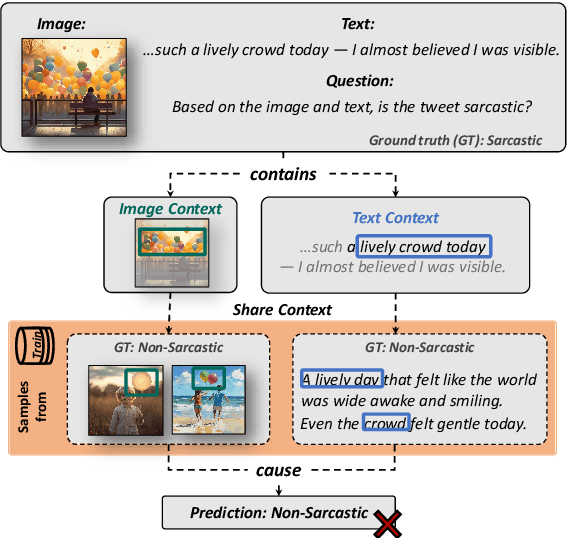
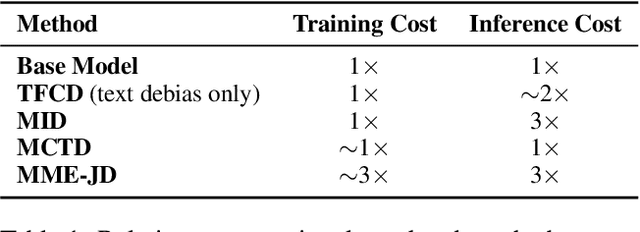
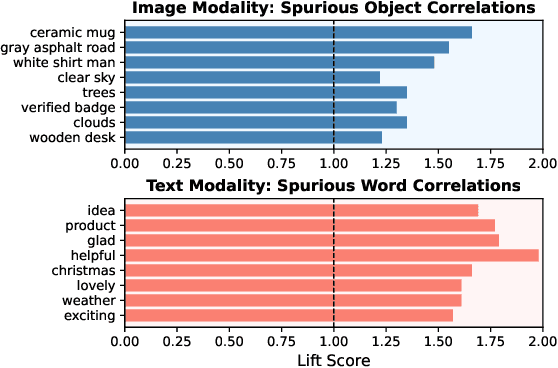
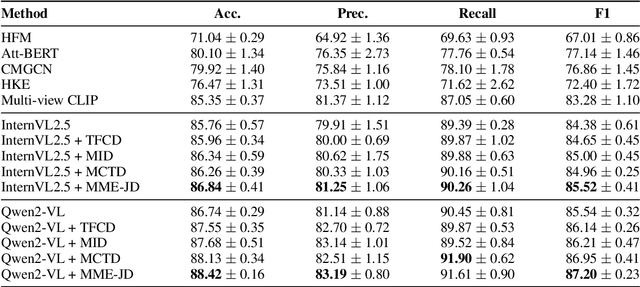
Multimodal Large Language Models (MLLMs) have shown substantial capabilities in integrating visual and textual information, yet frequently rely on spurious correlations, undermining their robustness and generalization in complex multimodal reasoning tasks. This paper addresses the critical challenge of superficial correlation bias in MLLMs through a novel causal mediation-based debiasing framework. Specially, we distinguishing core semantics from spurious textual and visual contexts via counterfactual examples to activate training-stage debiasing and employ a Mixture-of-Experts (MoE) architecture with dynamic routing to selectively engages modality-specific debiasing experts. Empirical evaluation on multimodal sarcasm detection and sentiment analysis tasks demonstrates that our framework significantly surpasses unimodal debiasing strategies and existing state-of-the-art models.
Beyond Words: Enhancing Desire, Emotion, and Sentiment Recognition with Non-Verbal Cues
Sep 19, 2025

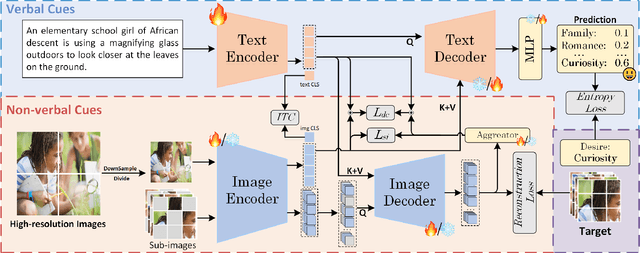
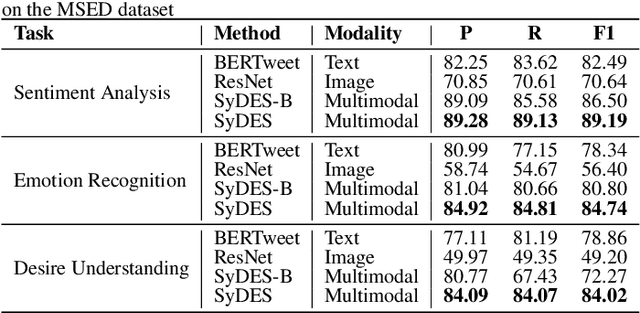
Desire, as an intention that drives human behavior, is closely related to both emotion and sentiment. Multimodal learning has advanced sentiment and emotion recognition, but multimodal approaches specially targeting human desire understanding remain underexplored. And existing methods in sentiment analysis predominantly emphasize verbal cues and overlook images as complementary non-verbal cues. To address these gaps, we propose a Symmetrical Bidirectional Multimodal Learning Framework for Desire, Emotion, and Sentiment Recognition, which enforces mutual guidance between text and image modalities to effectively capture intention-related representations in the image. Specifically, low-resolution images are used to obtain global visual representations for cross-modal alignment, while high resolution images are partitioned into sub-images and modeled with masked image modeling to enhance the ability to capture fine-grained local features. A text-guided image decoder and an image-guided text decoder are introduced to facilitate deep cross-modal interaction at both local and global representations of image information. Additionally, to balance perceptual gains with computation cost, a mixed-scale image strategy is adopted, where high-resolution images are cropped into sub-images for masked modeling. The proposed approach is evaluated on MSED, a multimodal dataset that includes a desire understanding benchmark, as well as emotion and sentiment recognition. Experimental results indicate consistent improvements over other state-of-the-art methods, validating the effectiveness of our proposed method. Specifically, our method outperforms existing approaches, achieving F1-score improvements of 1.1% in desire understanding, 0.6% in emotion recognition, and 0.9% in sentiment analysis. Our code is available at: https://github.com/especiallyW/SyDES.
SentiMM: A Multimodal Multi-Agent Framework for Sentiment Analysis in Social Media
Aug 25, 2025
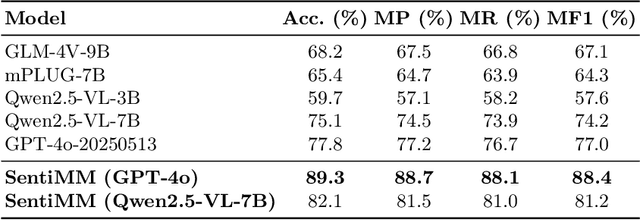


With the increasing prevalence of multimodal content on social media, sentiment analysis faces significant challenges in effectively processing heterogeneous data and recognizing multi-label emotions. Existing methods often lack effective cross-modal fusion and external knowledge integration. We propose SentiMM, a novel multi-agent framework designed to systematically address these challenges. SentiMM processes text and visual inputs through specialized agents, fuses multimodal features, enriches context via knowledge retrieval, and aggregates results for final sentiment classification. We also introduce SentiMMD, a large-scale multimodal dataset with seven fine-grained sentiment categories. Extensive experiments demonstrate that SentiMM achieves superior performance compared to state-of-the-art baselines, validating the effectiveness of our structured approach.
Disentangling Bias by Modeling Intra- and Inter-modal Causal Attention for Multimodal Sentiment Analysis
Aug 07, 2025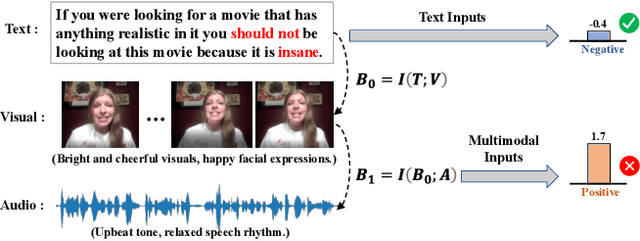
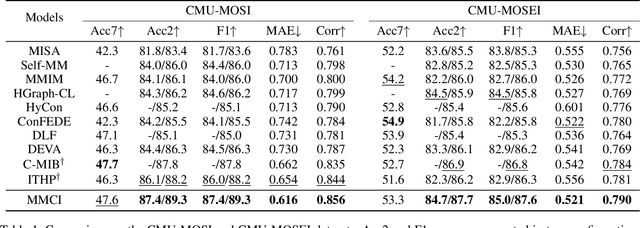
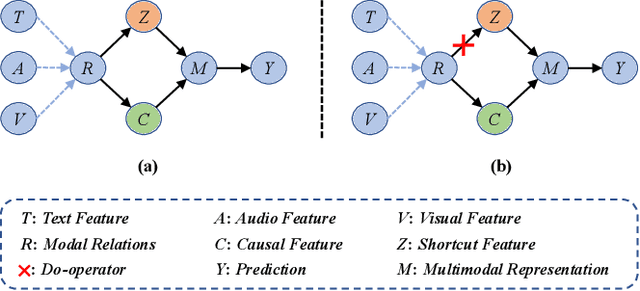
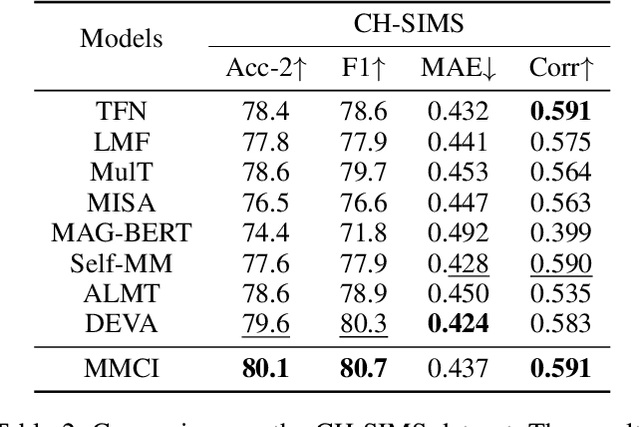
Multimodal sentiment analysis (MSA) aims to understand human emotions by integrating information from multiple modalities, such as text, audio, and visual data. However, existing methods often suffer from spurious correlations both within and across modalities, leading models to rely on statistical shortcuts rather than true causal relationships, thereby undermining generalization. To mitigate this issue, we propose a Multi-relational Multimodal Causal Intervention (MMCI) model, which leverages the backdoor adjustment from causal theory to address the confounding effects of such shortcuts. Specifically, we first model the multimodal inputs as a multi-relational graph to explicitly capture intra- and inter-modal dependencies. Then, we apply an attention mechanism to separately estimate and disentangle the causal features and shortcut features corresponding to these intra- and inter-modal relations. Finally, by applying the backdoor adjustment, we stratify the shortcut features and dynamically combine them with the causal features to encourage MMCI to produce stable predictions under distribution shifts. Extensive experiments on several standard MSA datasets and out-of-distribution (OOD) test sets demonstrate that our method effectively suppresses biases and improves performance.
A Multidimensional AI-powered Framework for Analyzing Tourist Perception in Historic Urban Quarters: A Case Study in Shanghai
Sep 04, 2025

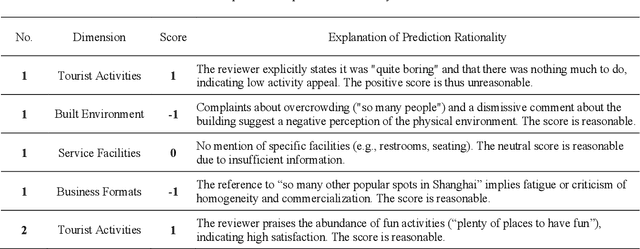

Historic urban quarters play a vital role in preserving cultural heritage while serving as vibrant spaces for tourism and everyday life. Understanding how tourists perceive these environments is essential for sustainable, human-centered urban planning. This study proposes a multidimensional AI-powered framework for analyzing tourist perception in historic urban quarters using multimodal data from social media. Applied to twelve historic quarters in central Shanghai, the framework integrates focal point extraction, color theme analysis, and sentiment mining. Visual focus areas are identified from tourist-shared photos using a fine-tuned semantic segmentation model. To assess aesthetic preferences, dominant colors are extracted using a clustering method, and their spatial distribution across quarters is analyzed. Color themes are further compared between social media photos and real-world street views, revealing notable shifts. This divergence highlights potential gaps between visual expectations and the built environment, reflecting both stylistic preferences and perceptual bias. Tourist reviews are evaluated through a hybrid sentiment analysis approach combining a rule-based method and a multi-task BERT model. Satisfaction is assessed across four dimensions: tourist activities, built environment, service facilities, and business formats. The results reveal spatial variations in aesthetic appeal and emotional response. Rather than focusing on a single technical innovation, this framework offers an integrated, data-driven approach to decoding tourist perception and contributes to informed decision-making in tourism, heritage conservation, and the design of aesthetically engaging public spaces.
Speech Emotion Recognition via Entropy-Aware Score Selection
Aug 28, 2025In this paper, we propose a multimodal framework for speech emotion recognition that leverages entropy-aware score selection to combine speech and textual predictions. The proposed method integrates a primary pipeline that consists of an acoustic model based on wav2vec2.0 and a secondary pipeline that consists of a sentiment analysis model using RoBERTa-XLM, with transcriptions generated via Whisper-large-v3. We propose a late score fusion approach based on entropy and varentropy thresholds to overcome the confidence constraints of primary pipeline predictions. A sentiment mapping strategy translates three sentiment categories into four target emotion classes, enabling coherent integration of multimodal predictions. The results on the IEMOCAP and MSP-IMPROV datasets show that the proposed method offers a practical and reliable enhancement over traditional single-modality systems.
Resource-Limited Joint Multimodal Sentiment Reasoning and Classification via Chain-of-Thought Enhancement and Distillation
Aug 07, 2025The surge in rich multimodal content on social media platforms has greatly advanced Multimodal Sentiment Analysis (MSA), with Large Language Models (LLMs) further accelerating progress in this field. Current approaches primarily leverage the knowledge and reasoning capabilities of parameter-heavy (Multimodal) LLMs for sentiment classification, overlooking autonomous multimodal sentiment reasoning generation in resource-constrained environments. Therefore, we focus on the Resource-Limited Joint Multimodal Sentiment Reasoning and Classification task, JMSRC, which simultaneously performs multimodal sentiment reasoning chain generation and sentiment classification only with a lightweight model. We propose a Multimodal Chain-of-Thought Reasoning Distillation model, MulCoT-RD, designed for JMSRC that employs a "Teacher-Assistant-Student" distillation paradigm to address deployment constraints in resource-limited environments. We first leverage a high-performance Multimodal Large Language Model (MLLM) to generate the initial reasoning dataset and train a medium-sized assistant model with a multi-task learning mechanism. A lightweight student model is jointly trained to perform efficient multimodal sentiment reasoning generation and classification. Extensive experiments on four datasets demonstrate that MulCoT-RD with only 3B parameters achieves strong performance on JMSRC, while exhibiting robust generalization and enhanced interpretability.
The Sound of Risk: A Multimodal Physics-Informed Acoustic Model for Forecasting Market Volatility and Enhancing Market Interpretability
Aug 26, 2025



Information asymmetry in financial markets, often amplified by strategically crafted corporate narratives, undermines the effectiveness of conventional textual analysis. We propose a novel multimodal framework for financial risk assessment that integrates textual sentiment with paralinguistic cues derived from executive vocal tract dynamics in earnings calls. Central to this framework is the Physics-Informed Acoustic Model (PIAM), which applies nonlinear acoustics to robustly extract emotional signatures from raw teleconference sound subject to distortions such as signal clipping. Both acoustic and textual emotional states are projected onto an interpretable three-dimensional Affective State Label (ASL) space-Tension, Stability, and Arousal. Using a dataset of 1,795 earnings calls (approximately 1,800 hours), we construct features capturing dynamic shifts in executive affect between scripted presentation and spontaneous Q&A exchanges. Our key finding reveals a pronounced divergence in predictive capacity: while multimodal features do not forecast directional stock returns, they explain up to 43.8% of the out-of-sample variance in 30-day realized volatility. Importantly, volatility predictions are strongly driven by emotional dynamics during executive transitions from scripted to spontaneous speech, particularly reduced textual stability and heightened acoustic instability from CFOs, and significant arousal variability from CEOs. An ablation study confirms that our multimodal approach substantially outperforms a financials-only baseline, underscoring the complementary contributions of acoustic and textual modalities. By decoding latent markers of uncertainty from verifiable biometric signals, our methodology provides investors and regulators a powerful tool for enhancing market interpretability and identifying hidden corporate uncertainty.
 Add to Chrome
Add to Chrome Add to Firefox
Add to Firefox Add to Edge
Add to Edge